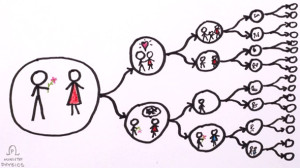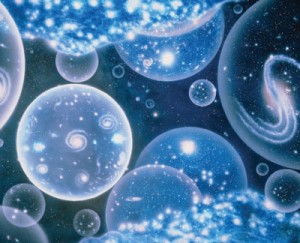Science Seen Physicist and Time One author Colin Gillespie helps you understand your world.
Three Roads to Multiverses
Last week we took a wide-lens look at the multiverse phenomenon that’s sweeping through the global physics village. Let’s look closer. South African cosmologist George Ellis says (about the simplest multiverses):
The proponents are telling us we can state in broad terms what happens 1,000 times as far as our cosmic horizon, 10100 times, 101,000,000 times, an infinity—all from data we obtain within the horizon. … We just do not know what actually happens, for we have no information about these regions and never will.
Who are the multiverse ‘proponents’? Here is a sample (in rough sequence):
1973 Bryce DeWitt; John Wheeler
1981 Alan Guth
1982 Andrei Linde
1997 Lee Smolin
2003 Paul Davies; Max Tegmark
2005 Steven Weinberg; Michio Kaku
2006 Stephen Hawking; Alexander Vilenkin
2011 Brian Greene; Leonard Susskind
2013 Nima Arkani-Hamed
What message can we see in such a list? Maybe two. First: In fundamental physics these are names to conjure with. Second: Recruiting them to sundry multiverses took some forty years. And, as we will see: They reach them by different roads.
 How did this begin? The math of quantum-mechanics seems to say that any quantum system is simultaneously in all possible states until an observer checks, thus forcing the system to choose one state. Think Schrödinger’s cat: QM math portrays its state as both alive and dead . . . until Schrödinger checks. In 1957 a physics student, Hugh Everett, found a way to resolve this: Each state―live cat, dead cat―is real and the act of observation sends them on their separate ways, each in its own universe. Elaborated by others, ‘many worlds’ interpretations of QM portray a vast multiplicity of universes.Smolin found this version hard to swallow, saying:
How did this begin? The math of quantum-mechanics seems to say that any quantum system is simultaneously in all possible states until an observer checks, thus forcing the system to choose one state. Think Schrödinger’s cat: QM math portrays its state as both alive and dead . . . until Schrödinger checks. In 1957 a physics student, Hugh Everett, found a way to resolve this: Each state―live cat, dead cat―is real and the act of observation sends them on their separate ways, each in its own universe. Elaborated by others, ‘many worlds’ interpretations of QM portray a vast multiplicity of universes.Smolin found this version hard to swallow, saying:
To postulate an infinite multiplication of the world because one is unable to resolve a problem of interpretation is a bit like moving and purchasing a new set of kitchenware each time one doesn’t feel like doing the dishes.
 In the end few favor this idea. Many who find a multiverse come to it not through QM but through one of many inflationary cosmology models that say the universe began with an assumption called ‘false vacuum’. It is a small zone of empty space with high energy density in the very early universe. (Where this comes from is a mystery.) A tiny fraction of a second after its beginning, it expands far faster than the speed of light. The vacuum rolls down its artificial energy hill thus turning into lots of something―a universe. This almost-instant universe seems to solve some fundamental problems (though I and others think it brushes them under a thick physics rug). But wait! There’s more. Some inflationary cosmology models can repeat this trick forever. Picture the early universe as a magician with white gloves and black hat. He pulls out, not just rabbits, but magicians. Etcetera and presto! You are looking at an endless multiplicity of universes. And, say some, like American physicist Brian Greene, ‘… we can imagine that physics varies from one universe to another.’
In the end few favor this idea. Many who find a multiverse come to it not through QM but through one of many inflationary cosmology models that say the universe began with an assumption called ‘false vacuum’. It is a small zone of empty space with high energy density in the very early universe. (Where this comes from is a mystery.) A tiny fraction of a second after its beginning, it expands far faster than the speed of light. The vacuum rolls down its artificial energy hill thus turning into lots of something―a universe. This almost-instant universe seems to solve some fundamental problems (though I and others think it brushes them under a thick physics rug). But wait! There’s more. Some inflationary cosmology models can repeat this trick forever. Picture the early universe as a magician with white gloves and black hat. He pulls out, not just rabbits, but magicians. Etcetera and presto! You are looking at an endless multiplicity of universes. And, say some, like American physicist Brian Greene, ‘… we can imagine that physics varies from one universe to another.’
 And then there are those whose favored multiverse arose from the so-called string-theory landscape. It has false vacuums in its basement but it heads upstairs into what American physicist Leonard Susskind calls ‘the diversity of environments implicit in string theory’. The meaning of this phrase is wrapped in string-theory math. Suffice to say that these string theories need six extra space dimensions. The six are tangled and the tangles have collapsed. They are far too small to detect. Calculations reveal from 10150 to 10500 unique tangles. That’s at least 1050 googols of them and at most a googol googol googol googol of googols. (Pray do not let this slight uncertainty dampen your enthusiasm. But feel free to google googol+google if you want to know how Google got its name.) Each one of these tangles gives rise to a distinct universe with―we are invited to suppose―its own physics. This, then, is the sweeping meaning of ‘diversity of environments’.
And then there are those whose favored multiverse arose from the so-called string-theory landscape. It has false vacuums in its basement but it heads upstairs into what American physicist Leonard Susskind calls ‘the diversity of environments implicit in string theory’. The meaning of this phrase is wrapped in string-theory math. Suffice to say that these string theories need six extra space dimensions. The six are tangled and the tangles have collapsed. They are far too small to detect. Calculations reveal from 10150 to 10500 unique tangles. That’s at least 1050 googols of them and at most a googol googol googol googol of googols. (Pray do not let this slight uncertainty dampen your enthusiasm. But feel free to google googol+google if you want to know how Google got its name.) Each one of these tangles gives rise to a distinct universe with―we are invited to suppose―its own physics. This, then, is the sweeping meaning of ‘diversity of environments’.
The bottom line on all three of these notions: While they may come wrapped in fancy math, they are only what physicist Sir Roger Penrose, speaking with that Brit civility of Stephen Hawking’s Grand Design, calls ‘just nice ideas’. As Ellis says, ‘None of the claims made by multiverse enthusiasts can be directly substantiated.’ Or indirectly for that matter. By explaining anything that anybody can imagine they explain nothing.
In other words, they are not physics and they never will be. This is a serious objection to their intrusions into physics journals.
Next: How can we explain this phony-physics epidemic?
Sources:
Lee Smolin (1997), The Life of the Cosmos, New York: Oxford University Press, p. 263; http://leesmolin.com/writings/life-of-the-cosmos/
Brian Greene (1999), The Elegant Universe, New York: Vintage Books, p. 367; http://www.briangreene.org/?page_id=20
Raphael Bousso & Joseph Polchinski (2004), “The String Theory Landscape”, Scientific American, New York, September, p. 79; http://www.scientificamerican.com/magazine/sa/2004/09-01/
Roger Penrose (2010), interview by Justin Brierley, Unbelievable, London: Premier, September 25; http://www.premierchristianradio.com/Shows/Saturday/Unbelievable/Episodes/Unbelievable-25-Sep-2010-Hawking-God-the-Universe-Sir-Roger-Penrose-and-Alister-McGrath
George Ellis (2011), “Does the Multiverse Really Exist?”, Scientific American, New York, August, p. 38; http://www.scientificamerican.com/article/does-the-multiverse-really-exist/
Other reading:
Clara Moskowitz (2014), “Multiverse Controversy Heats Up over Gravitational Waves”, Scientific American, New York, March 31; http://www.scientificamerican.com/article/multiverse-controversy-inflation-gravitational-waves/

these images are wrong. the mwi doesn’t imply many worlds , the name itself is wrong. there aren’t “many worlds” just many states. and only ONE WORLD.